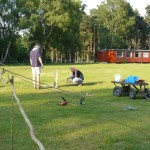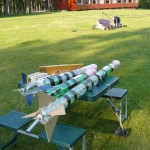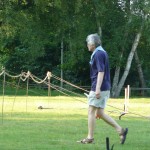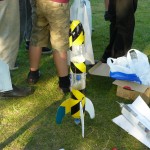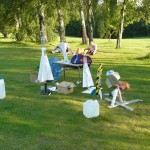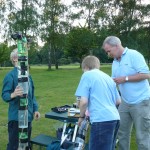I am proud to say that the hard work me and my scouts have put in over the last few months paid off, as we took home the trophy for the water rocket competition. Overall the competition was a great success with 6 teams entering and lasting for just under 2 hours. All the scout groups who took part thoroughly enjoyed themselves and we are looking to repeat next year.
Despite winning the competition, I wasn’t happy with the performance from the rockets. Below is a brief summary of the launches.
Louie
Louie, the large 4 bottle rocket struggled to accelerate up to speed and when it did, it veered off to the right, into a tree. The second launch was more vertical but didn’t achieve near the height I was hoping for and the parachute failed to deploy, badly damaging the parachute module on impact. I believe the parachute failed to deploy in this instance due to the string holding the door getting tangled, although the impact shock it so much I can’t be sure. Louie was retired after this, as we needed to try and get a good air time record.
On post calculations after the competition, I believe the cause of Louie’s poor performance to be due to low launch pressure. Louie weighs around 600g and was filled with bout 1600-1800ml’s of water. When I put those numbers into a simulator, at 70 psi the rocket would have struggled to have got off the launcher. The first launch was done at 80 psi and second at 90 psi. Its quite clear to see that the first launch had only marginally more pressure than what was needed to lift the rocket a couple of feet.
Doing some more calculations, 120psi would have gone over 300ft and 130psi was starting to near 400ft. Before this I had given up on 4 bottle rockets thinking the size of the nozzle we use are two small. But on reflection if we can get enough pressure in them, I think they should perform very well.
Huey
Huey was used for the third air time record, its first flight ended in disaster as the rocket powered up to a record height and then proceeded to fall with no parachute. I think the parachute may have not opened due to the angle of the light sensors. When the last two circuits were made, they had longer wires on the light sensors meaning that they pressed against the inside wall of the bottle, making them point more vertically. With the low position of the sun in the sky at launch I think it may have caused the circuit to be unable to determine the orientation of the rocket. Anyway the parachute module was destroyed on impact.
The last two flights for Huey were for egg recovery’s. For the first flight I had managed to repair the parachute module from Louie and to my delight it worked, safely bringing the egg back to the ground. However as I pressed the reset button on the parachute module for the next launch, a wire came unsoldered, rendering the module useless. I launched again with no parachute but to no surprise the egg was destroyed. As a comical finish the rocket then got chewed up by a dog shortly after crash landing.
Dewey
Dewey was the only rocket that consitantly performed. As the horizontal rocket it acheived the top 3 distances every time.
I hope to post some further anaylsis over the next few weeks after I have watched some of the video footage. As well as some videos and pictures and some ideas for what can be improved on for next year.









